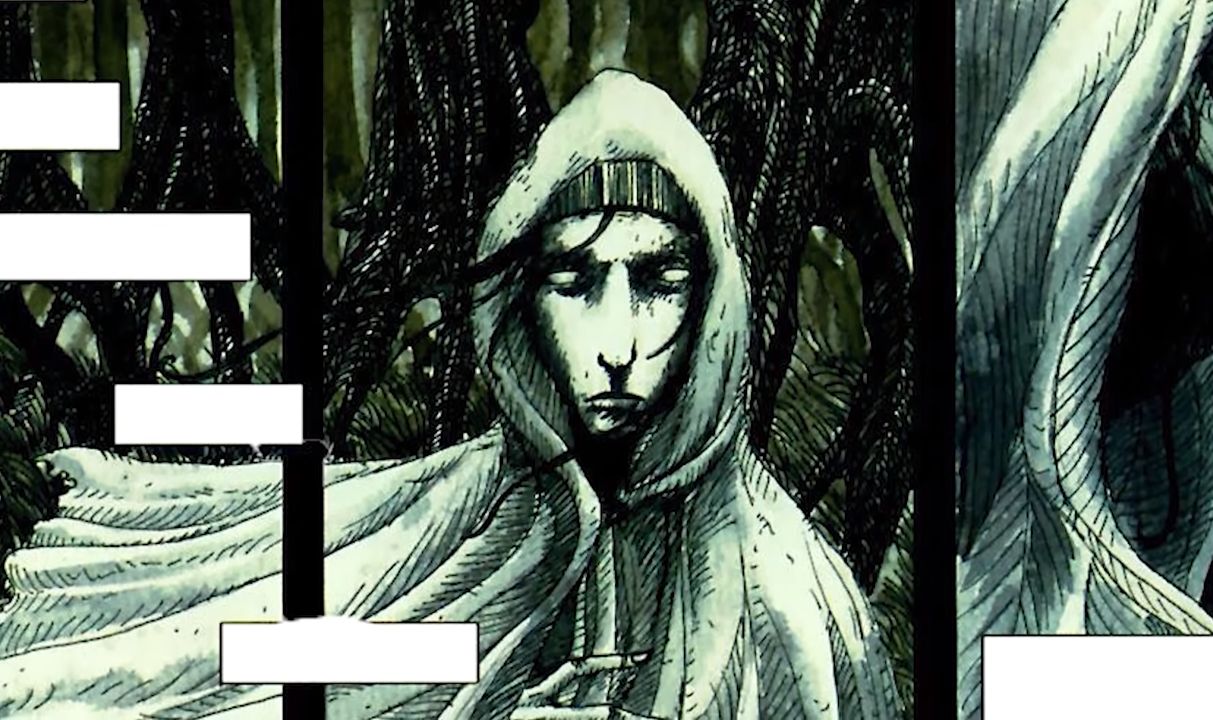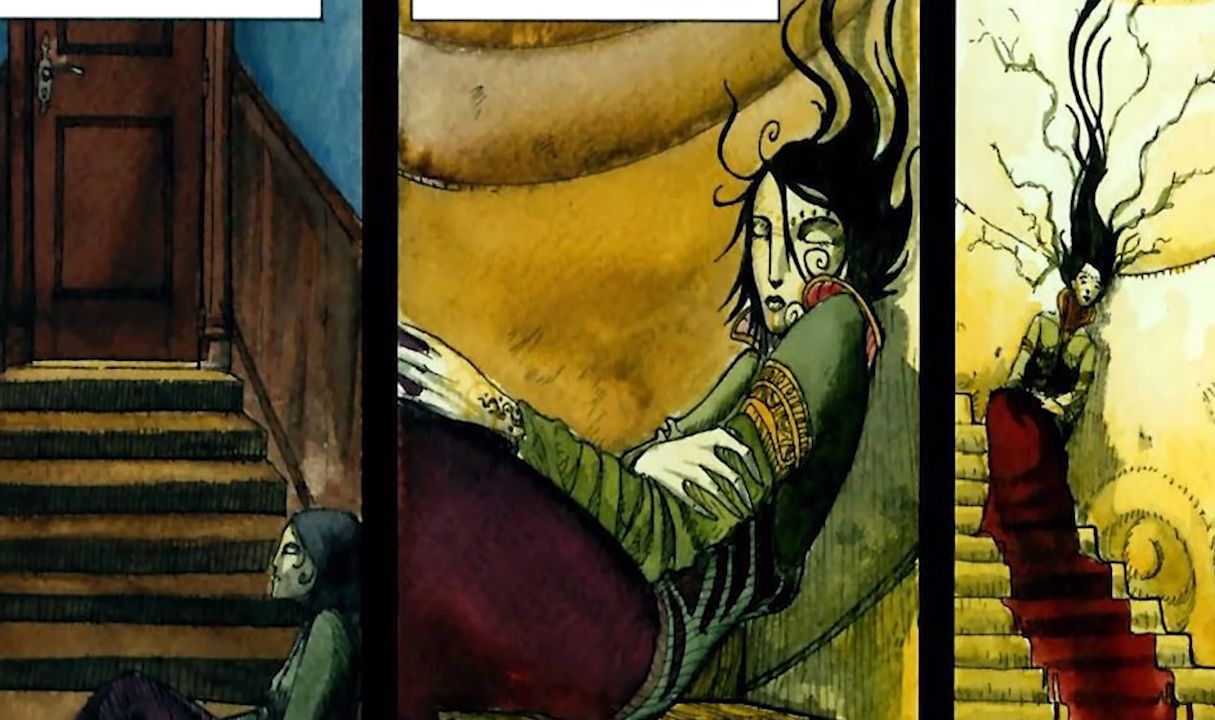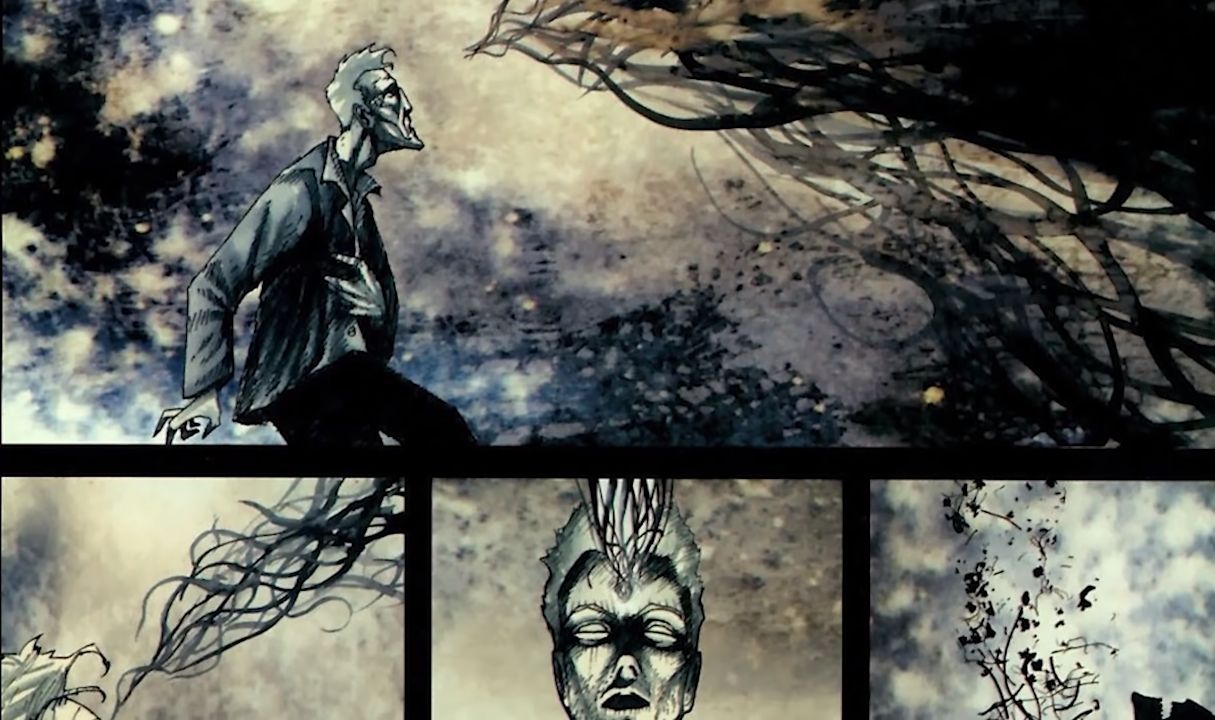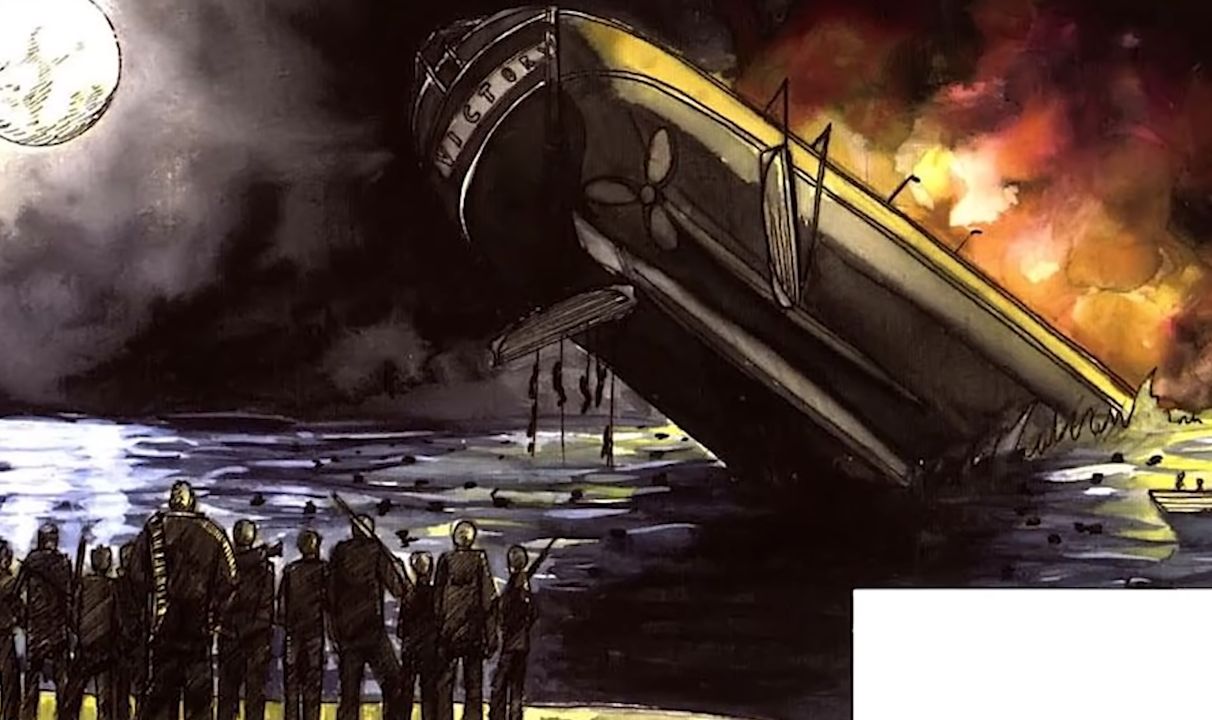You are losing out on all the fun if you have never read any of H.P Lovecraft’s stuff. This comic, on the other hand, would be a nice place to start and will give you a good idea of what all the commotion is about. This will remind people who have read Lovecraft’s work and are familiar with his style why he is considered a master of horror. This is a terrifying and twisted horror comic that is well worth your time!
Howard Phillips Lovecraft is regarded as the “Father of Cosmic Horror,” a genre centered on the premise that humans are a minor, insignificant part of a much larger, older, and more powerful universe. As compared to what lies beyond our grasp and cognition, we are nothing.
H.P. Lovecraft’s short story “The Temple” was published in 1920. We are going to look at the comic adaptation of this story today. Hernan Rodriguez adapted and drew it. In one volume, the comic collects five of his short stories. It is a fast read that will keep you on the edge of your seat.
The Stranger

“The Stranger” is written in the first-person narrative style, and it depicts the terrible and seemingly lonely life of a person who appears to have never met anybody else. The narrator begins the story by outlining his background. His memories of others are hazy, and he can’t seem to recall any specifics about himself, such as who he is or where he came from.
The narrator describes his surroundings: a dark, decrepit castle surrounded by an “endless forest” of tall trees that block out the sun’s light. He has never seen natural light or spoken to another human being, and he has never left his prison-like abode. The narrator’s only awareness of the outside world comes from his perusal of the “ancient books” that crowd the book racks on his castle’s walls.
The narrator describes his eventual determination to break out from what he perceives to be a prison-like existence. He resolves to climb the high castle tower’s ruined stairway, which appears to be his sole hope of seeing the sky. This leads him to begin a long, tedious journey up the tower wall from where the steps end in crumbling ruins until he eventually finds a trapdoor in the ceiling, which he pushes up and climbs through.
Surprisingly, he is not at the vast height he expected, but rather at ground level in another universe. He is thrilled as he gazes at the full moon, for he has never seen the vast open sky or the glorious light of the moon. He is overcome with emotion at seeing what he had only read about up in
books till now. He takes in his new surroundings. He finds he’s in an old churchyard and travels out into the countryside till he comes to another castle.
The narrator notices a crowd of people having a party inside the castle, which he finds “maddeningly familiar.” He climbs through a window into the room, yearning for human contact. The folks inside are afraid of him, as soon as they see him enter… They scream and rush out of the room, many stumble blindly toward the walls with their hands over their eyes in quest of an exit.
He looks about the room for anything that might be lurking in the shadows, but he doesn’t see anything. He detects a presence as he advances toward one of the room’s alcoves and approaches it gently. He loses his equilibrium and touches the thing, which results in his astonishment and amazement.
Horrified, he flees the building and returns to his castle, where he tries unsuccessfully to crawl back into his former world via the grate. Since the time he stretched his fingers towards the creature’s paw in the alcove and felt nothing but the “cold and unyielding surface of polished glass” of a mirror, the narrator has been in shock: riding with the “mocking and welcoming ghouls on the night breeze,” forever and officially an outsider.
In a letter, Lovecraft stated that this story is inspired by the work of Edgar Allen Poe. The horror during the party echoes the unmasking moment in “The Masque of the Red Death,” while the opening paragraphs parallel those of Poe’s “Berenice. “Some analysts believe “The Outsider” is autobiographical, and that when Lovecraft wrote, “I always know that I am an outsider; a stranger in this century and among those who are still men,” he was referring to himself.
I feel like this is a story about anyone who suffers from low self-esteem, anxiety, or a feeling that you don’t belong. It is highly relatable with a few rather poetic dialogues. It brings out the loneliness and misery of human life and isolation.
The music of Eric Zahn

Our protagonist, Miss Annette, cannot afford a flamboyant address so starts to live in a modest apartment building on the “Rue d’Auseil.” The street, which is close to his institution and is bordered by a river, gloomy warehouses, and a big wall, gives the impression that it is on a cliff.
There is only a single window on the top floor of the building, which has a view over the wall, the student is unable to see what is on the other side. One of the few other residents, in addition to the building’s crippled landlord, Blandot, is an elderly German man named Erich Zahn.
The elderly gentleman is tone-deaf and mute, but he plays his violin with the local theatre orchestra. On the top floor, he lives alone and plays weird music that the pupil has never heard before.
Blandon exposes the identity of the violin-playing tenant to Annette. One evening, she approaches him in the corridor and asks if she can listen to his music, despite Zahn’s reclusiveness. Zahn gives in and lets the student into his room. He performs some of his own melodies for the pupil, which is unlike anything the student has heard before. The student requests that he play the music, that she had heard the previous night.
Zahn is caught aback by the request: uncomfortably humming and whistling the chords he recalls and casts an anxious glance at his room’s curtained window. The pupil recognized the window as the only one with a view of the mystery street’s end wall. She approaches it, to peer outside, but Zahn yanks her back fiercely.
The pupil is quite taken aback by Zahn’s oddities and thinks of him as rude, but Zahn starts to explain the reason in writing. Zahn returns to his antisocial conduct, and his health deteriorates once the student moves, eventually refusing to listen to the student at all.
Annette’s desire to hear the hidden music and gaze out the window intensifies and she begins listening to Zahn while he performs till late at night. Zahn’s tunes have an otherworldly quality to them, and she hails him as a musical genius. The woman hears a disturbance and the shrill sound of the violin drowning a bunch of other sounds inside while discreetly eavesdropping outside Zahn’s chamber one night.
When she knocks, Zahn welcomes her inside and asks her to wait while he writes, promising to explain everything. Zahn is interrupted by a distant sound in the form of a low note now nearly an hour into composing, and he begins furiously playing his violin in a crescendoing panic. The music is obscene, and the woman assumes Zahn is yelling to drown out or keep something out of the room.
Zahn appears to be in a trance, doing nothing but playing his music. A burst of wind shatters the window, and another sound from outside the room, which the student interprets as mocking them, is heard. Despite her best efforts, the unusual wind sweeps through the room, blowing Zahn’s unopened papers out the window. Finally, the girl recalls her interest and glances out the window. She sees just a dreadful black emptiness, an infinite gulf of chaos, instead of the city lights.
The room’s candles are extinguished by the roaring winds and cacophony of elements, leaving her in complete darkness. Later, the woman recounts the experience, claiming that despite her best attempts, she has never been able to locate the Rue d’Auseil. It isn’t marked on any map, and it appears that no one else has heard of it. But she’s relieved that she can’t discover the street or the misplaced papers that could have explained Erich Zahn’s music.
This story is just something else. It left me with so much surprise that I didn’t know how exactly to cope with it. If something that I was mesmerized by suddenly disappeared without any explanation or if someone who is very sweet to me suddenly became rude, I don’t know how I would react. Lovecraft and Rodriguez have done a great job explaining the feelings and creating a realistic premise that leaves you curious, scared, and hungry for more.
Nyarlathotep

The story opens in the sense of a peculiar and incomprehensible purpose of foreboding felt by humanity, as a whole, in anticipation of great unknown evil. Citizens of a country seem to be concerned by the arrival of Nyarlathotep. Two men argue about the god-like man, and one feels genuine dread by the appearance of the entity while the other thinks that the god-like man on earth would know what is going on in the world and can solve all their problems.
The comic follows Nyarlathotep’s arrival in the narrator’s city and the consequences they face. We see a flashback of one of the incidents with Nyarlathotep, “of the old local blood” who and like a Pharaoh, appears in Egypt and claims to have “risen up out of the gloom of twenty-seven millennia” and to be receiving communications from other realms, according to the narrative.
As he goes from city to city showing his inventions and powers, he appears to have a profound understanding of the sciences, develops marvelous and incomprehensible devices, and gains a tremendous reputation. Wherever Nyarlathotep goes, the locals are afflicted with horrific dreams. The entire town seems to be screaming on his arrival.
Even as the electric street lights begin to fail, Nyarlathotep drives the watchers out of the hall, furiously insisting to one another that they are not terrified and that the city around them is untouched and alive. Nyarlathotep’s effect was so strong that the narrator seemed to have forgotten his daughter’s name.
Everyone goes into a trance and wanders off, dividing into at least three columnal groups: the first vanishes around a corner, from which an echoing moan can be heard; another descends into a subway station with the sound of mad laughter; and the third, which includes the narrator, travels outward from the city toward the country. The narrator tries his best to resist whatever urges all of the city people are feeling and marches into a dark gap through unseasonably cold snow. However, this approach is unsuccessful even though it delays the inevitable.
The novel concludes with the narrator witnessing a sequence of terrifying, surreal visions in which chaos and insanity reign supreme in an ancient, dying universe ruled by mindless, monstrous gods, whose messenger and “soul” is Nyarlathotep.
This story leaves one with a sense of foreboding. Not only are you left thinking of what happened, but you are also thinking about all the decisions you make. This story made me consider any decisions that I have made to this date and the ones that I will make any time soon. After this story, all I can think about how easy it is to get manipulated and how even the most minor decision can change everything. It also leaves me scared with a simple thought, “What if willpower isn’t enough?”
The Nameless City

The Nameless City follows an equally nameless protagonist as he journeys deep into the Arabian desert in quest of a city that predates all known human settlements. The protagonist appears to be an archaeologist, but it’s unclear if he’s a professional. He’s visiting these ruins alone for some reason.
He isn’t the one who discovered the ruins. He mentions the other folks who are aware of the ruins and avoid them. He appears to be the first brave/dumb enough to investigate them. Unless you count Abdul Alhazred, whom Lovecraft is unlikely to include for a variety of reasons. Superstitious and believers as they were, they said a quick prayer and decided to explore the nameless city.
Out of the three men, the one who looks the oldest and perhaps the wisest of them claims to have known it to be cursed from the first moment he saw the city. The stars aligned with the sphere of the town, and it seemed to come alive. It started glowing, and the travelers decided to descend into the nameless city and its unknown abyss. His torch goes out as he lands, and he crawls on his hands and knees until he reaches a hallway lined with small wooden coffins with strange reptiles inside.
The travelers think that the djinns created this place. The narrator notices a significant amount of light from an unknown source. He finds a big brass door with a drop into a hazy portal after crawling to it on his hands and knees. Then he hears wailing from the coffin passage and feels a mighty wind trying to drag him down.
Against all obstacles, he fights back, and behind the illuminated portal, he sees what appear to be reptiles with bodies shaped like a hybrid between a crocodile and a seal, as well as a bizarre head with a projecting forehead, horns, a lack of a nose, and an alligator-like jaw. After the last of the wind has flowed down into the light, the door closes behind the narrator, leaving him alone in the dark.
Something starts happening with the emergence of the light. One’s body turns reptilian out of the three men while the other becomes a corpse. The third one is left to deal with the madness till it pushes him off the brink. He impales himself on his sword and looks at the sky. It is a true slow burn madness that really gets to me. Lovecraft keeps proving to us why he is considered the father of cosmic horror, with each story creating a thrill more incredible than the one before.
The Temple

This story is based on a manuscript discovered in a bottle off the shore of Yucatan. Karl Heinrich, Graf (Count) von Altberg-Ehrenstein, Lt. Commander of the Imperial German Navy, and commander of the submarine U-29, is the author’s proud introduction. He can offer his specific coordinates along with the exact dates of the sequence of events he experiences. A succession of unexpected tragedies has resulted in this terrible fall in German precision.
One of the deceased is discovered clinging to the submarine’s railing after the U-29 destroys a British freighter and sinks its lifeboats. Karl notices his dark, excellent looks and assumes he’s an Italian or Greek who became involved with “English pig-dogs” by accident.
Karl’s lieutenant, hands up the ivory carving that he had stolen from the dead man to a crewman. It depicts the head of a laurel-crowned youngster, and its antiquity and workmanship astound the commanders. The crew is shocked to see the corpse’s open eyes as they dump it overboard. The corpse, according to Old Mueller, swam away. The officers chastise the crew for their “peasant stupidity” and expressions of dread.
The following day, some crew members are bewildered and are unwell after having dreams. There looks to be an uncharted southbound current. Even Klenze, like the dolphins that are now circling the submarine, gets irritated by minor details. According to Mueller, the victims of the U-29 are peering through the portholes.
He is silenced with a lashing, but two of the sick men become dangerously mad, prompting “dramatic steps.” Mueller and another man vanish—they must have gone overboard in the dark, driven by their illusions to commit suicide. Karl believes that these occurrences are the result of their long journey.
The U-29 is on its way home when the engine room is disabled by an unexplained explosion. The dolphins are escorting the submarine as it moves south. A crewman recommends surrender when an American battleship is detected and is shot for his cowardice. The U-29 submerges to avoid the cruiser and is unable to surface.
The crew erupts in a full-fledged mutiny, screaming about the “cursed” ivory skull and destroying essential equipment. Karl dispatches them with his trusty sidearm while Klenze is dazed. The U-29 continues to sink due to the whims of the southerly current. Klenze is prone to binge drinking and excessive sorrow for its victims.
On the other hand, Karl maintains his Prussian stoicism and scientific fervor as they descend, researching the marine life and vegetation. The dolphins fascinate him since they don’t surface for breath or leave when the water pressure increases. Although death appears certain, Karl finds solace in the fact that the Fatherland will honor his memory.
They’re getting close to the water floor. Klenze notices anomalies that he believes are sunken ships and carven ruins. Then he shrieks, “He is calling!” as he tries to depart the submarine with Karl in tow. They must go forth and be forgiven while he still treats them with mercy. Staying sane and defying him will only get you into trouble.
Karl enables Klenze to escape the submarine after recognizing that he is now a threat. His face is obscured by a swarm of dolphins. Karl laments the loss of his final companion and the ivory carving that Klenze refused to give up while he was alone. He is haunted by the image of that laurel-crowned head.
He climbs the conning tower the next day and is astounded to discover the U-29 approaching a drowned metropolis. The southernly current runs out of steam. The dolphins have left. The U-29 lands on a ridge and a massive building carved out of solid rock rise beside it, close by. The destination appears to be a temple. Columns and a frieze sculpted with religious themes and processions in adoration of a bright young god surround the colossal entryway. The art is indescribably gorgeous, and it appears to be the ideal ancestor of Greece’s classical splendor.
Karl explores in a diving suit. He intends to enter the shrine, but the suit’s light cannot be recharged. He only dares to take a few steps into the gloomy interior. For the first time, I’m intrigued by warfare. Karl ruminates in the dark submersible, conserving what little power he has left.
He wonders if Klenze was correct, that by declining his summons, Karl sets himself up for a dreadful end. He also notices that the ivory head and the temple’s radiant god are the same! Karl takes medication to help calm down his jittery nerves. He dreams of the cries of the drowning and lifeless faces pressed against the porthole glass. The lifelike, mocking face of the fisherman who carried the ivory head is among them.
He feels compelled to enter the temple as he wakes up. He is plagued by hallucinations, seeing phosphorescent light pouring through the portholes and hearing chanting voices. He sees “the doors and windows of the undersea temple…vividly aglow with a flickering brightness, as from a tremendous altar-flame far within” from the conning tower. The chanting begins once more. He sees objects and movement within, sights that are too fantastic to explain.
Despite the fact that Karl is aware of his delusions, he is compelled to comply. Despite this, he will die peacefully, “like a German.” He gets his diving gear ready. Klenze couldn’t possibly be correct. That couldn’t be demonic laughing, can it? Allow him to “go fearlessly up the steps into that primitive shrine, that hushed the secret of unfathomed waters and uncounted years” and “release his bottled narrative to the vagaries of the sea.”
This story reminds me a lot of “The Lighthouse” and the mermaid figurine in it. The slow madness in both also makes both of them brilliant stories. Rodriguez’s graphics and illustrations make these horrifying comics even scarier. The colors are dark and foreboding, which complements all the stories. Rodriquez starts each story with a relatively lighter palette and ends them on a darker note. These gothic tales really make you realize Lovecraft’s worth as the master of terror.
